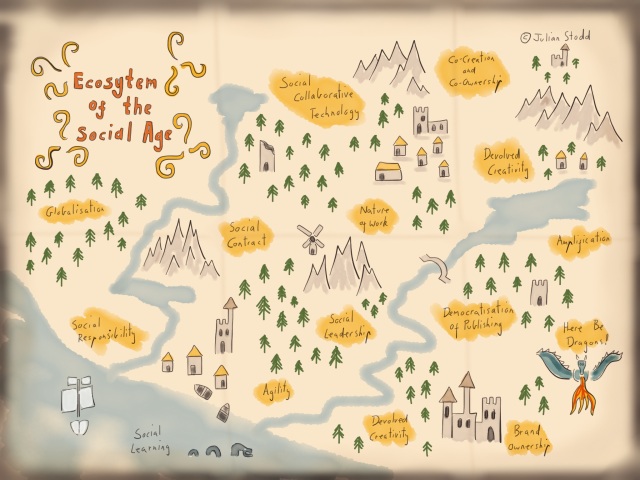I’m sat in the pub, but feeling strangely unsociable: it’s an odd feeling, surrounded by friends and friendly faces, but choosing to retreat behind the keyboard. It’s an easy defence: eyes down and typing, people are less willing to disturb you. Why? Maybe because it’s been a day of sharing, a day of openness, of conversation and presentation, a day operated at speed and, at some point, we have to stop to breathe.
I’m reflecting on that conversation: what are the trends the themes. What’s on my mind and how closely does it relate to what’s on everyone else’s: what have i learnt, what have i shared, what did we miss?
We covered broad ground: learning technology, social learning, measurement, sharing, change, curation, innovation and an underlying sense of fear.
Technology still underpins these type of events: the exhibition floor is filled with innovative companies (and some dinosaurs), all trying to convince us that they have the answer. Even if the question is less clear. It’s often still about infrastructure, with learning applications tagged on. Is there excellence? Absolutely: some superb technology, some superb innovation, some great design and usability. And an equal amount of the opposite. Technology won’t save us unless it’s combined by superb design and exemplary usability (which every system will tell you it has).
Don’t mistake disappointment for cynicism: my own work is rooted in technology. Technology facilitates and powers the Social Age: just not all of it. Too much technology is still a mechanism of control, under the auspices of the organisation. Truly social technology will be co-owned and democratised. It will be facilitating, not controlling. And it will iterate rapidly and talk to other systems easily.
I favour a diverse ecosystem of technology, to support agility and flexibility.
My own conversations have been very much about ‘Social‘, in particular how we design for it and how we measure it. The questions are the same: what can we do? When are other people doing it? How has it landed? What were the results? This is encouraging: we will only meet the promise of Social Learning is we learn ourselves: this is not one solution for all, but rather the evolution of a mindset and methodology that supports our learning and implementation.
Measurement is high on the agenda: curiosity how we can measure beyond convention, a desire for rigour (driven, i think, from a lack of rigour provided by the market: a market that fixates on ‘what/when/how long/score), there’s some disbelief that this problem is even close to being cracked.
Many people have Change on the mind: both of their own profession and more widely of the organisational space. And they are right to: the fundamental business models on which many organisations are based are eroding and evolving. Best to be on the lookout. There’s more awareness that this change is constant, but maybe less purposeful action that is required as a consequence. If we don’t adapt our organisational and personal skills and practices, we will be swept away. The lack of clarity is not a reason not to act: clarity is not needed for agility.
Curation is a word that comes up throughout my own and others work: but there needs to be a realisation that it’s not just about ‘social‘, it’s about reputation, leadership and how we learn. There’s an interest in curation technologies and products, but it needs to be matched with a conversations about permissions, ownership and trust.
Innovation is a hot topic: who is doing it, how are they achieving it? Again, for me, this is about how we share those stories, how we find our permissions, how we foster collaboration through community. I think innovation is still seen as something we need to do now and then, whilst in an agile mindset, it would be something we live. Something that helps us realise our potential, both individually and organisationally. And without it, we will be swept aside.
Finally: fear. I hate to say it, but there is still a sense of lethargy: that the changes we make are changes for the future. Because it’s big, because it’s hard, that doesn’t mean we don’t have to do it now.
There are some amazing teams here, some fantastic people and some organisations doing really superb work. But it’s in clusters. Few organisations as a whole are agile, are fit for the Social Age, and many are permeated by fear and denial, which may be reassuring, but won’t help you float.The pace of change is staggering: iterative and democratised. Asymmetric. But little notion of who is responsible for managing it, for saving us from it, for helping us surf it.
So day one has been exciting: lots of ideas, lots of conversations, lots of potential, but many challenges. Time to take up arms and lead the change.








Pingback: Reflections from CIPD Show 2015 Day 1 | Elearni...
Pingback: CIPD Show 2015 Day 2: Power and Control | Julian Stodd's Learning Blog
Pingback: Fear | ti.to
Pingback: Mirror mirror, on the wall | Lost and Desperate
Pingback: Reflections from CIPD Show 2015 Day 1 | Aprendi...
Pingback: What occured at #cipdldshow | e3ctc
Pingback: Fear | Rustic Learning Ramblings
Love the place of Social Learning on the Map of Ecosystem 🙂